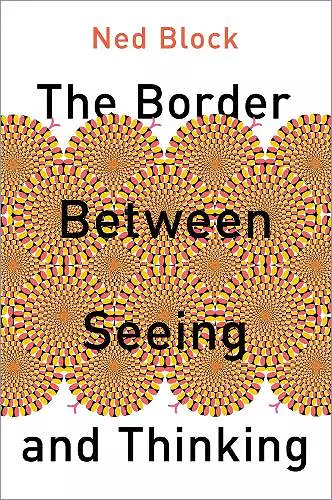The Border Between Seeing and Thinking
Format:Hardback
Publisher:Oxford University Press Inc
Published:17th Mar '23
Should be back in stock very soon

Philosopher Ned Block argues in this book that there is a "joint in nature" between perception and cognition and that by exploring the nature of that joint, one can solve mysteries of the mind. The first half of the book introduces a methodology for discovering what the fundamental differences are between cognition and perception and then applies that methodology to isolate how perception and cognition differ in format and content. The second half draws consequences for theories of consciousness, using results of the first half to argue against cognitive theories of consciousness that focus on prefrontal cortex. Along the way, Block tackles questions such as: Is perception conceptual and propositional? Is perception iconic or more akin to language in being discursive? What is the difference between the format and content of perception, and do perception and cognition have different formats? Is perception probabilistic, and if so, why are we not normally aware of this probabilistic nature of perception? Are the basic features of mind known as "core cognition" a third category in between perception and cognition? This book explores these questions not by appeals to "intuitions," as is common in philosophy, but to empirical evidence, including experiments in neuroscience and psychology. This is an open access publication, available online and distributed under the terms of the Creative Commons Attribution-Non Commercial-No Derivatives 4.0 International licence (CC BY-NC-ND 4.0), a copy of which is available at http://creativecommons.org/licenses/by-nc-nd/4.0/. Enquiries concerning use outside the scope of the licence terms should be sent to the Rights Department, Oxford University Press.
The great virtue of Block's discussion is its blending of philosophy and science, instigating an exciting empirical agenda to test his claims. Does cognition never adapt? Do all perceptual properties adapt? Do Block's signatures generalize to nonhuman animals, artificial systems, or other senses? Can iconicity account for the full breadth of visual representation? Whatever the answers, Block's approach offers deep insight into two fundamentally different aspects of mind. * Chaz Firestone and Ian Philips, Science *
This is a major work in the philosophy of perception. Its central insight is that many debates in philosophy of perception not only assume a distinction between perception and cognition, but often assume a specific way to draw it. That's why giving a theory of the distinction is such a fertile project, and why the book treats so many of the issues that shape contemporary work in this area - including the nature of consciousness, modularity, cognitive penetrability, and the differences between perception and memory, conceptual and non-conceptual contents, and propositional and non-propositional structures for content. The book invites responses along two dimensions: by engaging Block's theory of what grounds the distinction between perception and cognition, or by engaging what he says about the topics he treats in defending this theory. For this reason, the book has made a big impact. * Susanna Siegel, Edgar Pierce Professor of Philosophy, Harvard University *
Powerfully-argued, steeped in relevant science, and overflowing with insight, Block's landmark book will shape and stimulate debates about perception and thought for years to come. * Ian Phillips, Bloomberg Distinguished Professor of Philosophy and Brain Sciences, Johns Hopkins University *
ISBN: 9780197622223
Dimensions: 162mm x 242mm x 41mm
Weight: 921g
560 pages